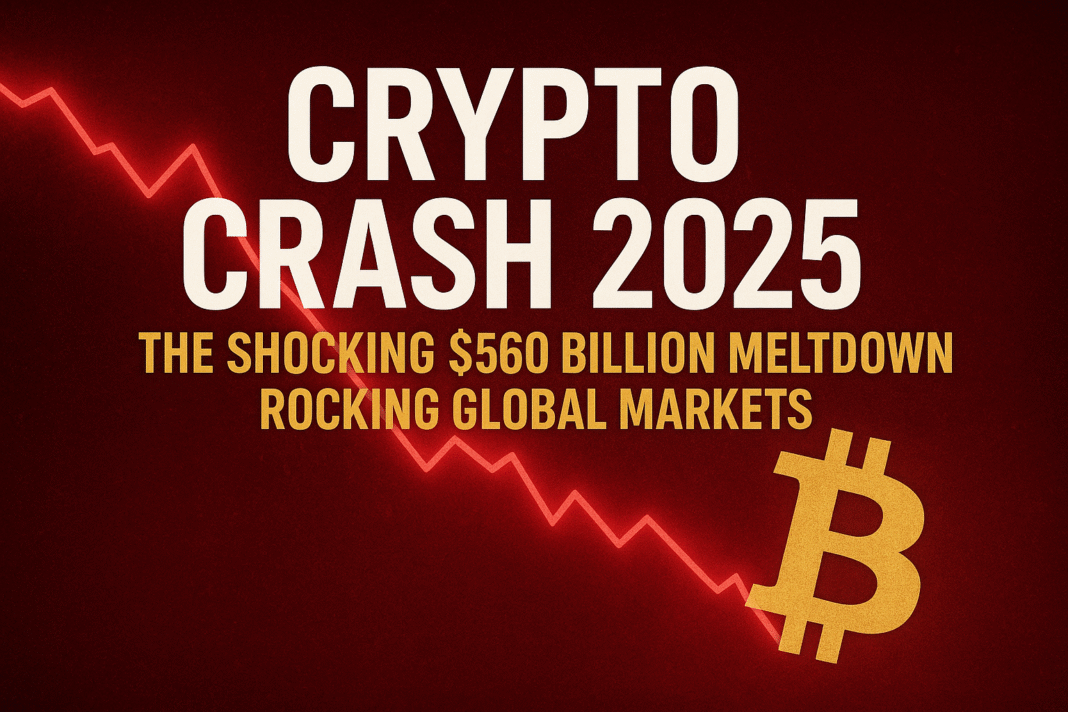Crypto Crash 2025 – Introduction

The crypto world was shaken to its core in early October 2025 when a sudden and brutal crash wiped out an estimated $560 billion in total market capitalization in just 24 hours. The catalyst? A shocking announcement by former U.S. President Donald Trump, declaring potential 100% tariffs on all “critical software” and goods from China. The statement sent shockwaves across global markets, triggering what analysts now call the largest liquidation event in crypto history.
The Lead-Up to the Crash

Before the crash, the market was full of optimism. Bitcoin had just touched a record high of $126,000 on October 6th, 2025, fueled by institutional demand and ETF enthusiasm. Traders were bullish, and crypto Twitter was buzzing with predictions of Bitcoin reaching $150K before the end of the year.
But beneath the euphoria, there were warning signs — over-leveraged traders, inflated valuations, and a market teetering on thin liquidity.
Timeline of the Crash — How It Unfolded
When Trump made his tariff announcement on Truth Social around October 10th, markets reacted almost instantly. Within an hour, more than $7 billion in long positions were liquidated as panic set in.
This triggered a cascading liquidation spiral — where forced selling drives prices lower, causing more liquidations, creating a domino effect. Major exchanges like Binance and Bybit struggled to keep up, reporting temporary outages and delays as trading volumes skyrocketed.
By the end of the day, over $19 billion in leveraged positions had been wiped out — a record-breaking event that will be remembered for years.
The Impact by the Numbers
- Bitcoin (BTC): Fell from $126,000 to below $103,000, later stabilizing near $111,000–$115,000.
- Ethereum (ETH): Dropped 14% to around $3,742.
- XRP: Tanked more than 22%, while Solana (SOL) and Cardano (ADA) fell 20%–30%.
- DeFi Tokens: Many lost 40% of their value in minutes.
- Total Market Cap: Fell from $4.30 trillion to $3.74 trillion.
- Trading Volume: Soared by 140%, showing the extent of panic selling.
Why Was the Market So Vulnerable?
The crash wasn’t just about tariffs — it exposed deep structural weaknesses in the market:
- Overleveraging
Thousands of traders had open high-leverage positions. Even small dips triggered automatic liquidations, amplifying the sell-off.
- Institutional Panic
Large institutions, spooked by fears of a renewed U.S.–China trade war, pulled back aggressively from risk assets, including crypto.
- Technical Weakness
Bitcoin was already facing resistance near $126,000, and the upward momentum was fading. Analysts say the market was “ripe for correction.”
Ripple Effects Across DeFi and NFTs
The chaos didn’t stop with traditional tokens. The DeFi and NFT ecosystems took heavy collateral damage.
Stablecoin De-pegging
Several stablecoins briefly lost their dollar peg, including wrapped assets and algorithmic tokens.
Oracle Failures
Some DeFi platforms suffered centralized oracle breakdowns, leading to false pricing and unjust liquidations.
NFT Market Slump
NFT trading volume dropped over 60% overnight, with blue-chip collections like BAYC and Azuki losing floor value rapidly.
Global Market Reactions
Traditional markets mirrored crypto’s chaos. Asian exchanges opened with deep losses, while European investors rushed to liquidate crypto holdings. In the U.S., institutions switched to a risk-off mode, reallocating funds to bonds and commodities.
Expert Opinions and Market Analysis
According to Edul Patel, CEO of Mudrex, this correction may be a “healthy reset” that flushes out excessive speculation. Analysts believe the approval of new spot altcoin ETFs could bring back investor confidence once volatility cools down.
However, skeptics warn that macroeconomic instability and geopolitical uncertainty could keep markets under pressure for months.
Long-Term Implications for the Crypto Market
Despite the bloodbath, crypto veterans see opportunity amid chaos. Historically, major crashes have often preceded strong bull runs. With excessive leverage cleared out, the market may find a more sustainable foundation for growth.
Geopolitical Tensions and Economic Uncertainty
The 2025 tariff threat has reinforced a key truth: Crypto doesn’t exist in isolation. When global superpowers clash, even decentralized assets feel the tremors. Trade wars, inflation fears, and monetary policy shifts all play critical roles in shaping crypto’s future.
Advice for Investors in a Volatile Market
- Risk Management Is Everything – Never invest more than you can afford to lose.
- Avoid High Leverage – It’s a double-edged sword.
- Diversify Wisely – Spread across different assets to cushion losses.
- Stay Calm and Think Long-Term – Volatility is temporary; innovation is not.
- Stay Informed – Global politics and economics now directly influence crypto.
What’s Next for the Crypto Market?
As the dust settles, traders are eyeing Bitcoin’s key support zones around $108K. A sustained bounce could reignite optimism, while a breakdown may trigger another leg lower.
Many believe that Q1 2026 could be pivotal — with ETF approvals and potential geopolitical easing on the horizon.
Conclusion
The October 2025 crypto crash serves as a powerful reminder that the market remains highly sensitive to external shocks. While painful for many investors, this event may ultimately help build a more resilient and mature ecosystem.
Crashes cleanse the system, and in the world of crypto, every storm eventually passes. For patient investors, the next rally might already be in the making.
FAQs
- What triggered the crypto crash in October 2025?
The crash was primarily triggered by Donald Trump’s announcement of a 100% tariff on Chinese goods, sparking fears of a renewed trade war. - How much was wiped out from the crypto market?
Around $560 billion in total market capitalization vanished within 24 hours. - Which cryptocurrencies were affected the most?
Bitcoin, Ethereum, XRP, Solana, and Cardano saw the largest declines, while smaller altcoins fell even harder. - Will Bitcoin recover from this crash?
Analysts believe Bitcoin may rebound over time, but short-term volatility remains high due to geopolitical uncertainty. - What lessons can investors learn from this event?
Avoid excessive leverage, diversify your portfolio, and remember that crypto markets move fast — both up and down.







